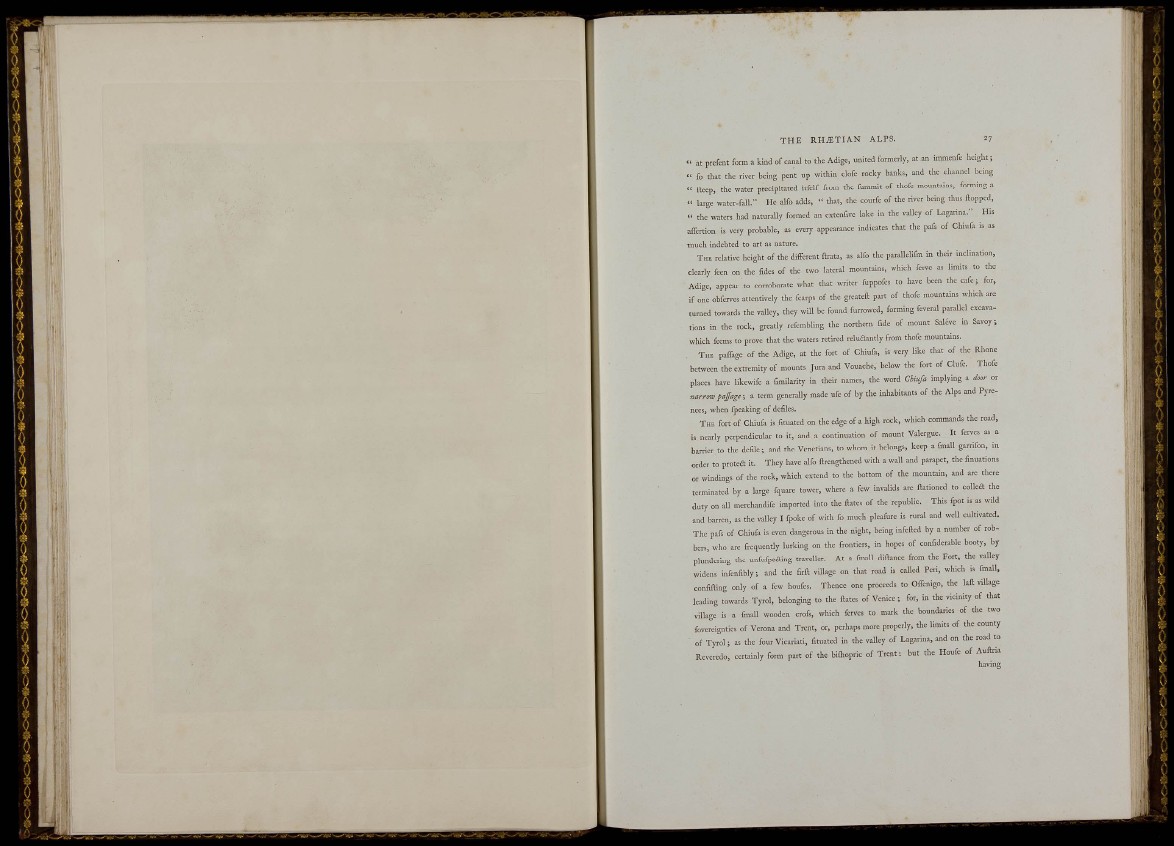
T H E R H j E T I A N ALPS . 2?
" at prefent form a kind of canal to the Adigc, united fotmcrly, at an imraenfe lieiglit ;
" fo that the rivet being pent np within dofe rocky banks, and the channel being
" fteep, the water precipitated itfelf from the fnmmit of tl.ofe monntains, forming a
" large water-fall." He alfo adds, " that, the conrfc of the river being thns flopped,
" the waters had naturally formed an extenfive lake in the valley of Lagarina." His
affertion is very probable, as every appearance indicates that the pafs of Chiufa is as
much indebted to art as nature.
TH. relative height of the different ftrata, as alfo the parallelifm in their inclination,
clearly feen on the fides of the two lateral mountains, which ferve a. limits to the
Adige, appear to corroborate what that writer fnppofes to have been the cafe; for,
if one obferves attentively the fearps of the greateft part of thofc mountains which are
turned towards the valley, they will be found furrowed, forming feveral parallel excavations
in the rock, greatly rcfembling the northern fide of mount Salive in Savoy;
which feem. to prove that the waters retired reludanlly from thofe motintaks.
TH, paffage of the Adige, at the fort of Chiufa, is very like that of the Rhone
between the extremity of mounts Jura and Vouache, below the fort of Clufc. Thofe
places have likewife a fimilarity in their names, the word CUuJa implying a itor or
a term generally made ufc of by the inhabitants of the Alps and Pyrenees,
when fpeaking of defiles.
TH, fort of Chiufa is f,mated on the edge of a high rock, which commands the road,
is nearly perpendicular to it, and a continuation of mount Valcrgue. It ferves as a
barrier to the defile; and the Venetians, to whom it belongs, keep a fmall garrifon, in
order to protefl it. They have alfo ftrengthcned with a wall and parapet, the finnations
or windings of the rock, which extend to the bottom of the mountain, and are there
terminated by a large fquare tower, where a few invalids are ftatloned to collefl tire
duty on all mcrchandife imported into the flates of the republic. This fpot is as wild
and barren, as the valley I fpokc of with fo much pleafure is rural and well cultivated.
The pafs of Chiufa is even dangerous in the night, being infcfted by a number of robbers,
who are frequently lurking on the frontiers, in hopes of confiderahle booty, by
plundering tl,e unfufpedhig traveller. At a fmall diftanec from the Fort, the valley
widens in°fenfibly; and the firft village on that road is called Peri, which is fmall,
confining only of a few houfes. Thence one proceeds to Offenigo, the laft village
leading towards Tyrol, belonging to the ftates of Venice ; for, in the vicinity of that
village is a fmall wooden crofs, which ferves to mark the boundaries of the two
foverdgnties of Verona and Trent, or, perhaps more properly, the limits of the county
of Tyr°ol; as the four Vicariati, f.tuated in the valley of Lagarina, and on the road to
Rcvcredo, certainly form part of the bifiloptic of Trent t but the Houfe of Auftria
having